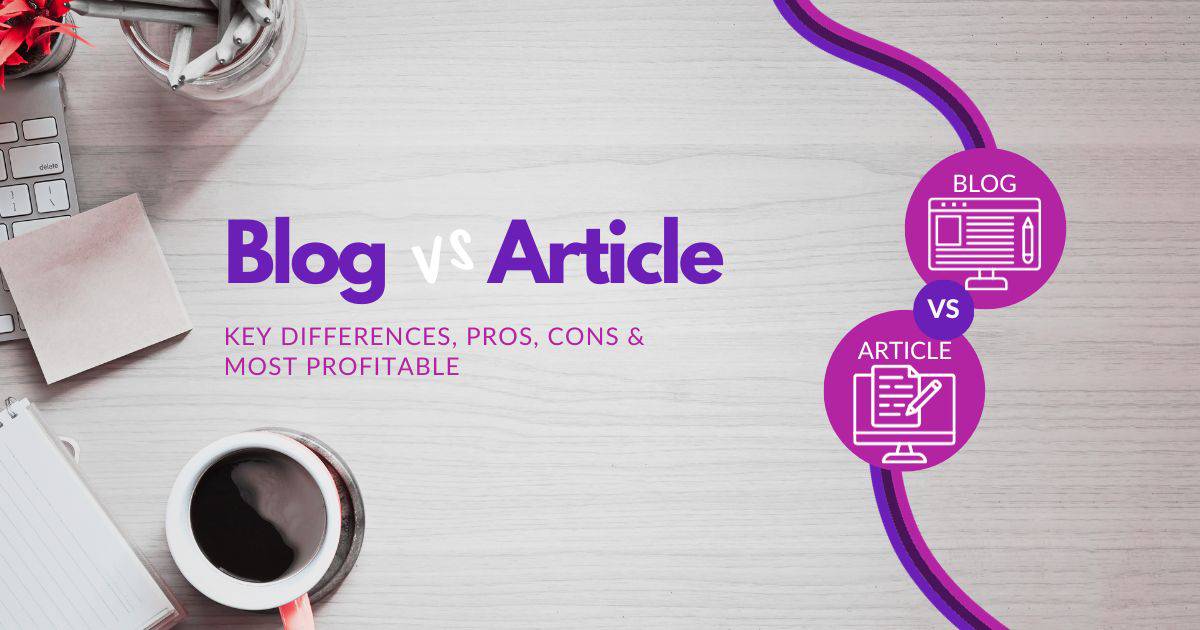Dissecting the differences between blogs and articles is more than an exercise in semantics; it’s a critical distinction for any savvy online communicator. A blog is your open mic on the internet—a space where personality and perspective reign, drawing readers with their relatability and often informal cadence.
As a seasoned digital marketer, I’ve seen the confusion these two mediums can cause for content creators and marketers alike. My expertise lies in crafting strategies that leverage the unique strengths of both to build brands and engage audiences. The insights I’ll share are grounded in direct experience with these mediums, ensuring they’re informative and immediately applicable.
Recognizing the nuances between a blog and an article is transformative for effective communication in our digital age. In the following sections, I’ll guide you through understanding and utilizing these differences to captivate and grow your audience, sharing the practical knowledge you need to excel in this dynamic space.
Blog vs Article Writing: Key Style and Format Differences
Grasping how blogs and articles differ enhances your ability to grab and keep a reader’s attention; let’s get into what sets them apart and how it can make your writing sharper.
Conversational Tone vs Professional Tone
Blog writing allows for a conversational tone using first-person pronouns, while articles maintain a professional tone using third-person pronouns. Bloggers can express their opinions and personal experiences more freely in casual writing, creating a friendly conversation in their posts.
This casual writing style allows for a more relaxed and conversational tone. On the other hand, articles focus on delivering information objectively, without personal bias or anecdotes.
Formatting Differences: Headings, Subheadings, and Bullet Points
Blogs often incorporate headings, subheadings, bullet points, and images to enhance readability. These elements break up the text and make it easier for readers to scan through the content quickly.
Using headings and subheadings, bloggers can create a clear structure that guides readers through different post sections. Bullet points help highlight key information or list items in an organized manner.
In contrast, articles follow a more structured format with an introduction, body paragraphs, and conclusion. They may include subheadings but tend to have fewer formatting elements than blogs. The focus is primarily on cohesively presenting information rather than using visual aids for enhanced readability.
Writing Style: Casual vs Formal Language
Blog posts can be written in a more relaxed manner with shorter sentences and paragraphs. The language used is often casual and informal, allowing bloggers to connect with their audience personally. This style aims to engage readers by being relatable and easy to understand.
On the other hand, articles require more formal language with longer sentences. Writers strive for clarity and precision when conveying information objectively. Complex sentence structures may be common in articles as they aim to provide detailed explanations or analysis.
Exploring if blogs and articles can be considered the same thing
Blogs and articles may involve written content published online but serve different purposes. Blogs focus on personal experiences or opinions, while articles provide factual information or analysis. The intended blog audience is usually broader, whereas articles target specific niches or industries.
Purpose: Personal Experiences vs Factual Information
Blogs are like online diaries where individuals share their thoughts, experiences, and opinions on various topics. They often include personal anecdotes and storytelling elements to engage readers.
On the other hand, blog posts are more subjective and opinionated, while articles are more objective and informative. They aim to provide readers with well-researched facts, analysis, or news about a particular subject.
Audience: Broad vs Niche
Blogs cater to a wider audience by covering various topics that appeal to people from different backgrounds and interests. They are accessible to anyone who stumbles upon them on the internet.
Articles, however, have a more targeted approach. They are crafted for specific audiences within niche industries or fields who seek specialized knowledge or information.
Flexibility: Structure and Style
Blogs offer flexibility in structure and style compared to traditional article writing. Bloggers can experiment with different writing styles, use informal language, incorporate multimedia elements like images or videos, and even interact with their readers through comments sections.
Articles generally follow stricter guidelines regarding formatting, tone of voice, language usage, and citation of sources.
Blog vs. Article: Navigating Content Strategies
Distinguishing between blogs and articles is critical for business owners and writers, guiding the choice of the optimal platform for content marketing. This distinction ensures strategies effectively resonate with the intended audience, aligning content with readers’ expectations on tone and style.
Strategically Tailoring Content
Choosing between a blog or an article can pivotally influence marketing outcomes. Blogs excel in boosting brand awareness through their conversational tone and capacity to engage readers. The formal tone and emphasis on the factual accuracy of the articles are tailored for lead generation and conveying in-depth product or service information.
This differentiation is crucial for SEO optimization, allowing writers to craft content that meets user search intent. Blogs, rich in keywords, cater to personal insights or experiences, enhancing search visibility. Articles focus on delivering authoritative, research-backed content, bolstering a site’s credibility.
- Blogs: Conversational tone, reader engagement, keyword optimization.
- Articles: Informative, authoritative stance, evidence-based.
This strategic content approach satisfies audience needs while improving online visibility and search engine rankings.
Effectively leveraging blogs and articles empowers businesses to refine their content marketing strategies, ensuring the delivery resonates with the targeted audience and fulfills specific marketing goals.
Know Your Readers: Tailoring Blogs & Articles
Knowing who reads your blogs and articles can transform your writing into something they want; let’s learn how to spot and write for your readers.
Blogs vs. Articles: Who’s Reading?
Blogs and articles have distinct audiences with different preferences and objectives. Blogs tend to attract a wider range of readers, including casual individuals seeking entertainment or personal insights.
On the other hand, articles target a specific audience interested in acquiring knowledge or information on a particular topic.
Engaging vs. Consuming
Blogs often take the lead. Blog readers actively participate by leaving comments and sharing content on social media platforms.
They enjoy interacting with the writer and fellow readers, forming a community around shared interests. In contrast, article readers typically focus more on consuming the content without active participation.
Emotional Appeal vs. Objective Information
Blog readers are more likely to be influenced by the writer’s emotions and personal experiences. They appreciate authenticity and relatability in blog posts that resonate with their own lives.
Conversely, article readers seek objective and reliable information backed by facts, research, and expert opinions.
The Power of Social Media
Social media plays a significant role in amplifying blog content to reach a broader audience. Bloggers rely heavily on social media platforms to promote their work, attract new readers, and build brand awareness. Article writers may also use social media but often prioritize other channels for distribution due to their focus on informative rather than entertaining content.
Understanding your target audience is crucial for effective content marketing efforts. Whether you write blogs or articles depends on your objectives and the people you want to reach. Consider factors such as reader engagement levels, emotional appeal versus objective information, and the role of social media in your content strategy.
Creating engaging content: hooks, techniques, and narrative structure

Hooks are essential in blog writing. They grab the reader’s attention right from the start. Whether it’s a catchy opening line or an intriguing question, hooks make your readers want to keep reading.
Techniques play a crucial role in making blog posts engaging. Storytelling is one effective technique that draws readers in by creating a connection with relatable experiences or emotions. Humor can also liven up your content and make it more enjoyable to read. Using relatable examples helps readers understand complex concepts better.
Adding Content Structure
Blog posts often follow a narrative structure that keeps readers engaged throughout the piece. The introduction sets the scene by presenting the topic and its relevance. Body paragraphs further develop the story or argument, providing evidence, depth, and supporting information. Finally, the conclusion summarizes the main points and gives readers a clear takeaway.
In contrast, articles may employ different techniques to engage readers intellectually. Data analysis can provide valuable insights and support arguments with evidence. Expert quotes add credibility and authority to your content.
When crafting engaging content, remember these key factors:
- Use conversational language and adopt a friendly tone.
- Consider your target audience’s interests and preferences.
- Edit your work thoroughly for clarity and coherence.
- Incorporate relevant SEO keywords to improve visibility on search engines.
- Align your content strategy with your brand voice and intent.
To illustrate this further, let’s consider an example of a blog post about healthy eating habits: Title: “5 Easy Ways to Boost Your Energy Levels Naturally”.
Example Blog Post Structure:
Introduction
- Hook: “Feeling tired all day? Discover simple tips to skyrocket your energy levels naturally!”
Body Paragraphs
- Technique: Storytelling – Share personal anecdotes about struggling with low energy levels before adopting healthy habits.
- Technique: Relatable Examples – Provide practical examples of nutritious foods and exercises that boost energy.
Over to You
Choosing between a blog and an article sets the tone for how your audience will receive your message. Blogs let you share a personal story, while articles present hard facts. Think about what you aim to convey with your next piece.
As you decide on your approach, remember your choice’s impact on engagement. Will your words be a casual conversation or a formal presentation? Your decision will pave the way for how your message is perceived and retained.
FAQs
What is the main purpose of a blog?
The primary purpose of a blog is to provide updated content on various topics, thereby engaging readers, establishing authority, and enhancing a website’s search engine optimization (SEO) by incorporating relevant keywords to attract more visitors.
How long should a blog post be?
The optimal length for a blog post for SEO is typically between 1,500 and 2,500 words. This range balances detail with readability, catering to search engine algorithms while providing comprehensive coverage of the topic to satisfy user queries.
Can an article be considered a blog post?
While all blogs fall under the category of articles due to their written nature, not all articles can be considered blog posts. Blog posts typically have a less formal tone than other articles found in academic journals or news publications.
How frequently should I update my blog?
Consistency is key. Updating your blog at least once a week is recommended to keep readers engaged and maintain an active online presence. However, the frequency can vary depending on your goals and available resources.
Are blogs suitable for business promotion?
Yes, blogs are an effective tool for business promotion. They allow businesses to showcase their expertise, provide valuable information to potential customers, and establish themselves as industry leaders. Blogs also help drive organic traffic to websites and improve search engine rankings.
What is the difference between blogs and articles?
Blogs are typically informal, regularly updated web entries reflecting personal experiences or opinions, often allowing reader interaction. Articles are structured, formal texts intended for publication, focusing on factual reporting and analysis without personal commentary. Both serve as content but differ in tone, style, and purpose.



